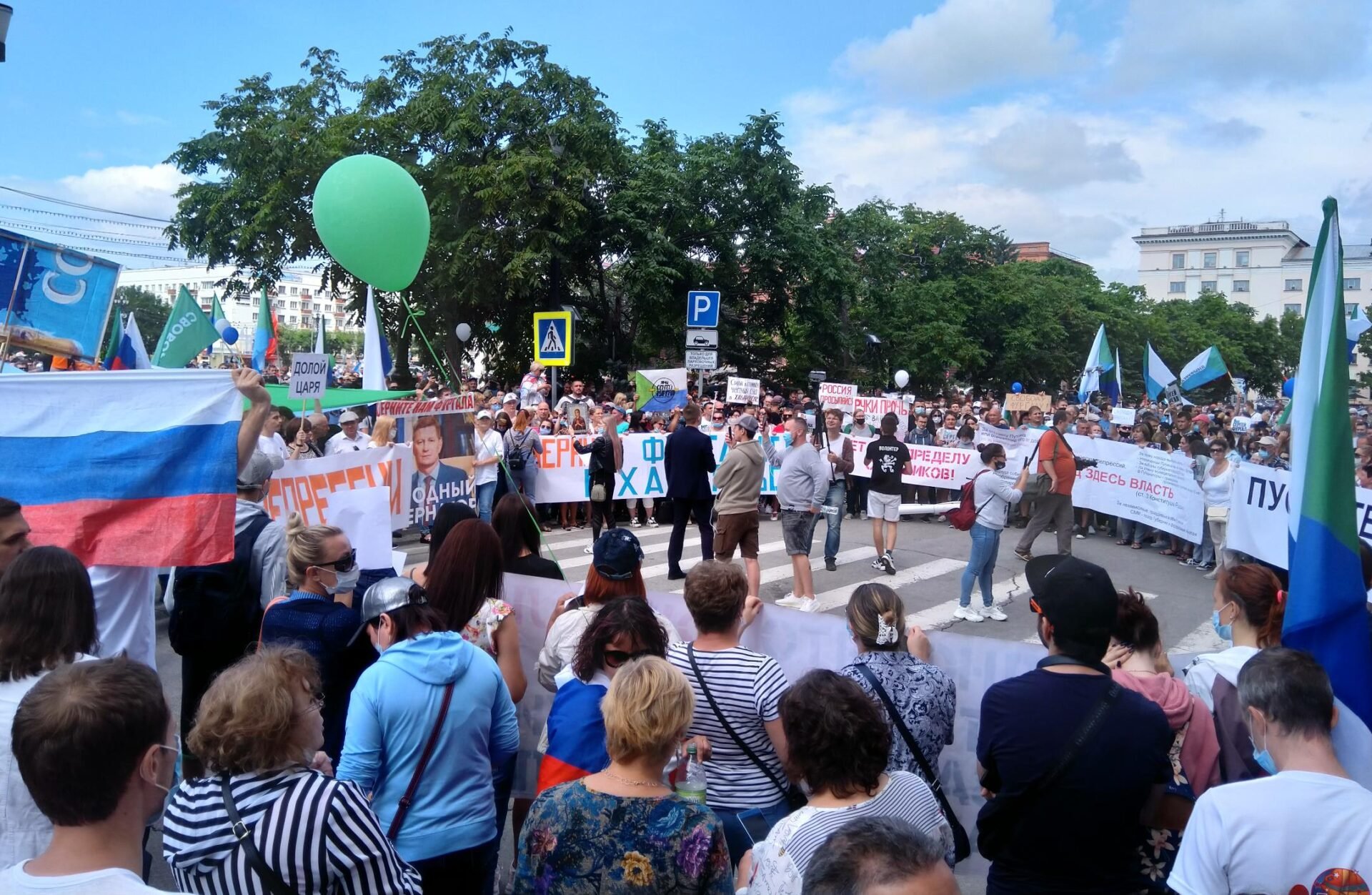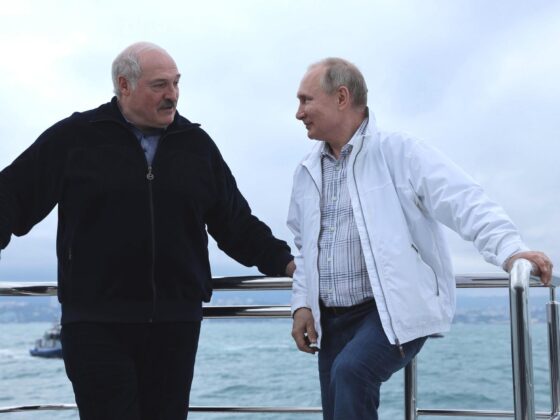In recent years, massive urban protests have taken place in the post-Soviet space. Some demonstrations have contributed to political change, like in Ukraine, while elsewhere, they made no difference or added restrictions, such as in Belarus and Russia. Recent protests took place in Kazakhstan in January 2022, beginning in a distant town due to high gas prices, spreading across the country, and contributing to at least a partial change of regime. Protests can happen quickly, switch to political appeals, and burgeon based on reserves of discontent. The best examples in Russia were when Alexei Navalny was imprisoned multiple times and also, more recently, against the February 2022 invasion of Ukraine, which led to the immediate arrest of thousands of protestors in over 50 Russian cities.[1]
To assess the accumulation of protest potential in Russia, we focused on regional cities over January-April 2021, looking not so much at the variation or number of participants but rather at the cities’ protest capability. We find that the highest potential is among young and educated urbanites who have civil society resources available. For example, Tomsk and Tyumen emerged as metropolitan areas with elevated protest potential, while Yekaterinburg maintained its traditional, high share of embedded oppositional attitudes. Each city has its own distinctions based on factors such as youth, governance, and Internet access. Although the research presented here was concluded before 2022, the recent eruptions in Kazakhstan, Russia, and elsewhere in the region—many prompted by the war—lend support to the latency of protest potential.
Political Protests in Russia
The political geography of urban political protests in Russia has changed dramatically over the last decade. The 2011-2012 protests “For Fair Elections” were provoked by multiple cases of electoral fraud during the 2011 parliamentary elections. They were mainly concentrated in Moscow and St. Petersburg, with Moscow accounting for 44 percent of all protest events in 2011. This situation changed by 2017 when anti-corruption protests spread across the country in March and June after Team Navalny’s release of its “On vam ne Dimon” (“He Is Not Dimon to You”)investigation into the affairs of Prime Minister Dmitry Medvedev. On March 26, somewhere between 36,000 to 88,000 people took to the streets in 97 cities, and the June 12 protests saw actions in 154 cities with participants numbering between 50,000 to 100,000.
In 2019 and 2020, political protests were registered in two regions, Moscow and Khabarovsk Krai. In the summer of 2019, thousands of Muscovites took to the streets over the rejection of nineteen opposition candidates to the Moscow City Government, demanding the election commission admit them. The arrest of the regional governor, Sergey Furgal, in July 2020, after he won an election over a Kremlin-backed, United Russia candidate, provoked much more massive protests in Khabarovsk. In two days after his arrest, which he called politically motivated, more than 60,000 people took to the streets, demanding his trial be relocated from Moscow to Khabarovsk. The protests continued for many months, but the demands of the people were ignored.
A new wave of political protests in Russian cities followed the return of Navalny to Russia and his arrest in January 2021. Protestors took to the street in his support in almost 130 cities on January 23, January 31, and February 2. These protests were violently suppressed by the police, with thousands of people fined and jailed.
Methodology and Factors for Protest
We define protest potential as an immediate readiness to participate in protest events. We concentrate on the readiness for political protests and not, for example, for economic or social protests. We thus examine protest potential in Russian cities with respect to federal and not regional or local agendas, with a focus on each city’s protest potential rather than on habitual metrics such as crowd size. We study cities as sites of accumulation of protest potential because urban residents have higher income and education levels and enhanced access to resources, such as media and civil society infrastructure.
To assess protest potential accumulated in the Russian regional capitals in January-April 2021, we collected data about the number of registrations (as of April 20, 2021) for the protest march in support of Navalny announced for April 21, 2021. We included 53 regional capitals in the analysis, excluding Moscow and St. Petersburg, the capitals of Russia’s ethnic republics, the centers of “autonomous okrugs” (administrative divisions; there are four [2]), and the cities of Simferopol and Sevastopol.
Social and political factors tend to play a major role in protest rallies in authoritarian contexts. Thomas Carothers and Richard Youngs highlight that, in recent protests in Azerbaijan, Belarus, Malaysia, and Russia, economic factors played only a minor role. Another study by Aleksandr Vatoropin and Aleksey Ruchkin on protest potential in the Sverdlovsk region found no connection between people’s willingness to take to the street and “the rise in unemployment, decreases in wages, and delays in their disbursement.” Therefore, we include social and political factors in our analysis.
We identified and examined the interplay of the following factors: a high share of young and educated in the population of a city, high Internet consumption, the presence of organized civil society, and the ineffectiveness of city authorities using ratings of governance (by the Agency for Political and Economic Communications or APEC). Qualitative Comparative Analysis (QCA) of 53 cases reveals that a high share of young and educated people and the presence of organized civil society are crucial for the accumulation of protest potential in Russian cities.
A Potent Mix of Factors Typified by Yekaterinburg
The results, on one hand, indicate that universities provide fruitful soil for the accumulation of protest potential. It is indeed plausible that young and educated people are able, at least, to get information that represents an alternative to state media propaganda (which avoids mentioning Navalny’s name, for example). On the other hand, organizational structures of civil society are also able to foster protest potential. Urban activists often have local agendas that may not be overly political, but organized civil society groups in regional cities can nourish protest moods with respect to both political and federal agendas.
Yekaterinburg represents the most typical case. It is the center of the Sverdlovsk region that in the early 2010s used to be at the top of ratings of democracy for Russian regions. The political centralization of the 2000s suppressed neither the competition between its elites nor the critical sentiments of its citizens. The concentration of opposition attitudes in the region is traditionally above the national average, in particular, among young and educated people. According to Vatoropin and Ruchkin, who construct a sociological portrait of potential protestors in the region, “60 and 11 percent of potential protestors have a higher and incomplete higher education, respectively.” Protestors are also, on average, 35 years old. Furthermore, the region ranks fourth after Moscow, St. Petersburg, and Tatarstan in terms of the scale of the NGO sector. It is noteworthy, however, that the region scores relatively low and is not even in the top 20 with regard to support for NGOs by regional authorities. At the same time, it is precisely such NGOs that create and maintain protest potential.
Overall, we find that protest accumulates within two groups of urban strata in Russia, intersecting with each other. Young and educated people fuel the protest ambiance through their energy. Civil society organizations, via developed communication channels, transmit this energy through their networks. The structural characteristics of urban communities are crucial for the accumulation of protest potential in Russia’s cities.
Three Special Cases: Stavropol, Tyumen, and Tomsk
The circumstances of Stavropol, Tyumen, and Tomsk require a more detailed discussion. Stavropol exhibits a high share of young and educated people and has a quite organized civil society but lacks protest potential. This can be explained by the fact that Stavropol has a peculiar administrative structure. In contrast to the majority of regions with a “center-periphery” structure (regional capitals are typically at the same time the largest cities as well as political and economic centers of their regions), Stavropol does not play a leading role in the region. Instead, an agglomeration of federal resorts called Caucasian Mineral Waters with a population of 1,200,000 people consisting of relatively small-sized cities together lead the region. Furthermore, Stavropol is part of the North Caucasian Federal District that also includes five republics of the North Caucasus (Chechnya, Dagestan, Kabardino-Balkaria, Karachay-Cherkessia, and North Ossetia). For this reason, this district is politically unstable and insecure. Federal and regional security services are present to a much greater extent there than in other regions, suppressing the slightest of protest moods.
Tyumen displays protest potential and as expected also has an organized civil society, but it lacks a high share of young and educated people. This case indicates that it is not only young and educated people who are ready to protest—middle-aged citizens are also ready to take to the streets. In fact, we can clearly observe the emergence of a broad societal coalition in the city. It includes people of different ages, education levels, and political views. Discussing the protest events between 2008 and 2012 in Russian regions, Andrey Semenov points out that in Tyumen in 2010, “communists joined diverse groups and organizations (from liberals to anarchists) in creating the Council of Initiative Groups and Citizens, which for a while became the major force behind the public protests, including the For Fair Elections campaign.” As a result, the communists cooperated with Navalny’s supporters during the 2011-2012 protests.
The case of Tomsk, on the contrary, suggests that protest potential can also accumulate in the absence of organized civil society. Tomsk is quite distinctive from other regional capitals because of its highly developed infrastructure of higher education. Despite its medium size, the city has six state universities, two of which have a higher status than national research universities. Tomsk has been capable of attracting young people from other cities. According to official statistics, the share of young people (18 to 40 years old) was 42 percent of the population (2018). Tomsk ranks third after Moscow and St. Petersburg based on the number of students per 10,000 people. Therefore, it is plausible that such an extremely high share of young and educated people facilitates the accumulation of protest potential within educational networks not attached to civil society structures.
Conclusion
Urban protests challenge the stability of political systems, both democratic and non-democratic. We can expect urban protests to continue to take place in the region. The way these protests have spread inside and to other countries has been highly uneven. We know that during previous waves of political protests (prior to 2021), Russia’s two main cities—Moscow and St. Petersburg—took the unambiguous lead in protest activities, while the protests in other large cities were much more modest. This was not the case in the winter of 2021 when the scale and geographic scope of the protests in other Russian places were far greater. Urban political protests in Russia thus appear to go in waves. This year, we saw a rapid upturn and a downturn of protest activity in Russia as detentions of anti-war dissenters intensified.[3] However, the protest potential is still there.
Irina Busygina is Professor at the Higher School of Economics, St. Petersburg.
Ekaterina Paustyan is Postdoctoral Researcher at the Universität Bremen.
[1] Navalny himself added to the domestic fray at the time, saying, “It was Putin and not Russia that attacked Ukraine.”
[2] Chukotka Autonomous Okrug, Khanty-Mansi Autonomous Okrug, Nenets Autonomous Okrug, and Yamalo-Nenets Autonomous Okrug.
[3] A 2022 law states that people sharing “fake” news about the war can be sentenced to 15 years in prison.











